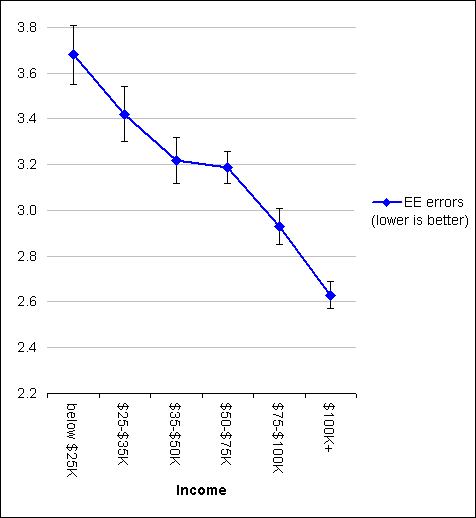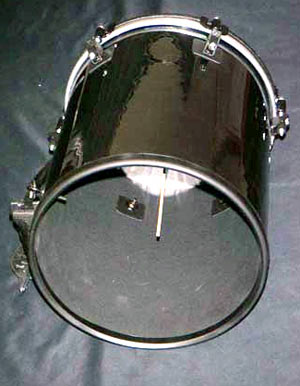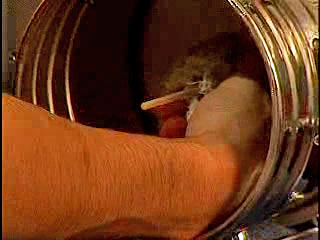A reader writes:
I wanted to bring your attention to Dream Acoustics speakers. I'm hoping you might review some.
I bought a set on eBay recently.
I replaced the surrounds on my Logitech Z-5500s with these, thinking they would do music better, and actually I am really quite impressed!
$120 for five speakers, including "full range" (almost) tower speakers!
Anyway, there is tons of cheap gear on eBay, all under "Dream Acoustics". I would love to see you write up your opinion on it, as I know audio is one of your specialities.
Stephan
Well, this is a weird situation. It's sort of like finding someone pulling the Violin Scam, except they're not claiming the fiddle's worth more than $5.
I don't think it's at all likely that "Dream Acoustics", or the other companies whose products are functionally indistinguishable from the Dream ones, would ever send me anything for review. There's a whole gaggle of them - "Pure Audio", "Omni Audio", "Dynalab", and the list goes on. Collectively, they're often known as "white-van speakers", because classically they're sold, at inflated prices, by scam artists in vans, to whoever they can flag down.
The Wikipedia article currently has a lengthy list of white-van speaker brands, as do other sources. Many white-van brand names are deliberately similar to the names of companies that make high-quality loudspeakers. Again, Dream Acoustics seem to be taking the high road here; they're not trying to sell speakers labelled "DunAudio" or "BJL" or "Woofdale" or "FEK" or some other brand you'd expect to see on a set of speakers in Grand Theft Auto.
The one unifying characteristic of all of these odd-branded speakers, of course, is that they are not actually very good. They're usually pretty nice-looking, but that's the most complimentary thing you can say about them.
If "Dream Hi-Fi" were to send me some of their speakers to review, I'd take them apart, photograph the humiliatingly small magnets on the backs of the drivers and the lightweight, under-braced enclosures (which may not have any damping material in them, not even a token handful of cotton waste...), and observe that speakers just like these have been made available to the public by blokes in white vans for many years now.
I've been hunting for people who've actually done acoustic and electrical measurements on these sorts of speakers, or better yet torn one down and looked inside, but unfortunately there's a pretty small intersection between the set of people who buy white-van speakers, and the set of people who know how to test speakers. A hi-fi outfit called GR Research, however, has looked at a few of them - but none of the articles are still on the GR Research site for some reason, so I had to dig them up from elsewhere, like archive.org.
Here's GR Research's piece about some "Dahlton" white-van specials, which the tester says have "the worst response curve I have ever measured on any speaker".
(Including, by the way, these "Digital Audio Titan Line Hammerhead Eagle iThrust 3810SL" white-van speakers he wrote a short piece about earlier. At the time, they had the worst response curve he'd ever seen. Another reviewer has suggested that one should expect these speakers to sound like a crate of donkeys falling down a staircase.)
The Dahlton speakers can, at least, manage the usual department-store-speaker big muddy 60Hz bass boom, provided you make sure to aim their side-firing bass drivers at a wall at the correct angle. (Bass response below the 60Hz resonance peak is pretty much zero.)
And yes, he opened the box, and found thin wood, no bracing, and no damping material. And a really cheap crossover - but at least there was a crossover, which is apparently not something you can necessarily count on in this sector of the market.
(Without a crossover, woofers will be trying to reproduce treble and overheating, tweeters will be trying to reproduce bass and distorting, and midranges will have both problems at once. Turn the volume well up and you will damage each driver in turn, starting with the tweeter.)
Oh, and apparently the Dahlton manual gives advice about bi-amping the speakers, but the speakers' apparently-electrically-separate terminals on the back panel are actually connected together inside the box. So anybody who actually tries bi-amping will probably blow up at least one amplifier!
There's also this piece (for some reason archived on someone's Comcast home page) about some "VMPS 626R" speakers, which are the worst speakers the GR Research guy has ever looked at that didn't (in this one case, at least) come from blokes in a van. Again, they've got lightweight cabinets with no bracing, but there is at least a tiny useless puff of damping material! The VMPS speakers also feature drivers that don't fit properly in the holes in the box, atrocious crossover design with slightly different components in each speaker, large changes in frequency response from small changes in listener position, and overall assembly quality that suggests that the people who put the speakers together were forced to do so in some sort of reeducation camp.
The difference between you, Stephan, and almost everybody else in the world who has bought speakers like this, is that you have not been ripped off. As you say, $AU120 (less than $US110, as of late July 2010) for five speakers is not a bad deal, even if the speakers aren't very good. As long as they don't have any of the special driver-popping, amp-killing features of the very worst of the white-van crowd - which even cheap eBay speakers really shouldn't have - you'll be fine.
I think this is a good opportunity for a further digression about the white-van scam. It's perpetrated every day in most, if not all, affluent nations, and it always works the same way.
There is, you see, a company that imports these could-be-mistaken-for-expensive speakers in great numbers for ridiculously low unit prices. The company does not sell the speakers directly. It instead - on paper, at least - sells them on consignment to a bunch of "independent contractors", who're the guys in the, usually white, vans. Those contractors then head out and look for suckers, spinning a story to explain why these super-expensive very nice speakers are so very cheap, today only, bargain of a lifetime, et cetera.
Perhaps they just fitted out a hotel or something and have one set of speakers left over, officially these lovely speakers are already installed along with all the others, the hotel's loss could be your gain, and so on. Or maybe these speakers, um, fell off the back of a truck into our van, mate, nudge nudge. There's almost always some sort of underhanded flavour to the story, as is the case with so many scams. One of the best ways to get money out of a mark is to make him think there sure is a scam going on, but he and the scam artists are in it together, ripping off someone else.
(People often expand this into the maxim "you can't scam an honest man", but that's rubbish. Of course you can scam an honest man. You just can't scam him with a technique like "would you like to buy this property which I strongly imply is not actually mine to sell?")
Officially, the speaker importers never tell the "speakermen" to do anything underhanded at all. They're just drivin' around askin' people if they'd like to pay $800, which is half the retail price, buddy, for sets of flimsy speakers that wholesale for fifty bucks.
Actually, the sky's the limit for the alleged "retail price" of these things. In the case of these examples....
...it's $3,659!
If you start haggling, the speakermen know they've got you. They can turn a profit from almost any final sale price, no matter how broken the mark believes the speakermens' balls have become. The only thing the speakermen have to do is remember to keep a straight face when they allow you to pay a mere $250 for those $50 speakers.
What usually seems to actually happen in the world of the speakermen is that the importers and the van men all get together at the beginning and end of each day and have themselves one of those SELL SELL SELL HAHA WE ARE THE MODERN HIGHWAYMEN STAND AND DELIVER scam-artist Come-To-Satan revival meetings.
Well, that's what I think you'd probably see if you hid a spy camera in the distribution warehouse (here's an actual hidden-camera exposé!). But if anybody ends up in court, it'll transpire that the distributors actually can't even clearly recall the speakermen's names, much less any information about what those crazy kids might have gotten up to.
The only speaker-scam van I can remember personally seeing was actually green, not white. White vans are apparently much more common than coloured ones, though, I presume because legit small commercial vehicles are so often white. Some white-vanners even go to the trouble of getting their dodgy speaker brand of choice painted on the side of the van - or, at least, printed on a big magnetic sign.
(I've probably actually seen many speaker-scam vans over the years, without knowing what they were. Only if the speakermen go for the time-honoured "shout at potential marks while you're all stopped at the lights" fishing techniques can you identify them in traffic.)
I think some really slippery crap-speaker manufacturers even made a few "genuine" speakers, which they sent to reviewers or put on display in a showroom... and then went into bulk production with their standard awful speakers, that resemble the good ones. I don't know whether any manufacturers are bothering with that now, though.
Getting back to the eBay speakers: The crucial difference between a $AU199-plus-delivery Dream Acoustics five-speaker set (the Buy It Now price seems to have gone up since Stephan bought his speakers), and their white-van brethren, is that the eBay sellers seem to be asking a quite fair price. The specifications are all outrageous fantasy, of course, but that's nothing new in the low-end audio market, and I think factory quality control is now good enough that the speakers do usually work, for suitably small values of "work".
(The current $AU199 Dream Acoustic 5-speaker sets claim a total power handling for the five speakers of nine hundred and fifty watts. Expect the voice coils to actually be slapping the end stops at maybe a twentieth of that power, not that this actually matters for even quite loud normal listening. The specs also shamelessly claim the main speakers have response from "35 - 22,000Hz". This is more bullshit, but it's the same bullshit you'll find on the spec-sheets for countless big-brand department-store speakers and amplifiers. My favourite example of this nonsense is the decorative response graphs printed on those plastic speaker-surround doodads for mounting six-by-nines on your sedan's parcel shelf.)
Shipping for a five-speaker set makes the bargain a bit less impressive. Melbourne metro delivery from "Dream Hi-Fi" is only $AU39 for a five-speaker set, but shipping to most other Australian capitals costs $AU79, and if you're out in the sticks a bit like me here in Katoomba, you're looking at $AU158. That's not a secret, though; just plug your postcode into the shipping calculator on their eBay listings.
UPDATE: The above eBay store no longer exists, as of late 2012. "MyDepot Online" has Dream Acoustics speakers now; there are also several people selling used sets.
(When I did a "completed listings" search on ebay.com.au, I turned up numerous five-speaker Dream Acoustics surround systems that've auctioned for little more than $AU100. That low-low-low sale price can be considerably pumped up by shipping charges, but if the all-told price works out at less than $AU40 per speaker, it's difficult to complain.)
I think I should also mention that you don't have to troll the lowest-priced eBay dealers or wait for some guy in a van to yell at you if you want to buy some crappy speakers. I mean, look at these preposterous Kenwoods from a few years ago. They may sound better than white-van speakers, but I wouldn't bet on it.
Companies that're famous for making speakers, and nothing else, seldom sell crap like this. Even Cerwin-Vega's world-renowned Speakers For Drunk University Students are way, way better than true department-store crap. If the brand of your speakers can also be seen on televisions, microwave ovens and jaffle irons, though, watch out.
(Do not buy a telescope from a department store, either.)
Oh, and as a general rule, the more closely the front panel of a one-box "mini hi-fi system" resembles the cockpit of one of those tanks from Tron, the more dire will be the quality of the actual sound, which is largely limited by the quality of the speakers. (You can substantially upgrade cheap mini-systems by hooking up just about any old pair of full-sized garage-sale speakers in place of the standard ones.) It's perfectly possible to buy one-box "hi-fi" systems that really do have quite high fidelity in the first place, though. Look for wooden speaker cabinets, and minimal dekotora-ism.
Getting back, finally, to Dream Acoustics, their US site links to Dway Corporation, their distributor here in Australia. Curiously, though, the multi-speaker sets listed on the Dway site are all much more expensive than the eBay speakers. Different models seem to come and go rather frequently; at the moment 5-speaker sets start at $AU499, and you can pay as much as $AU1299 for the fanciest set. Plus delivery, which can easily add more than $100 extra, as I found after doing the old pretend-you're-buying-something dance to get the site to tell me what shipping would cost.
(The US site has prettier pictures, but no prices. If everything there had a price north of $1000, then it'd look exactly the same as the Web sites set up to fool people into thinking that various kinds of white-van speakers are actually high-end gear. Note, just to be clear, that I am specifically not suggesting that Dream Acoustics are actually associated with the white-van scam. UPDATE: As of late 2012, both dreamacoustics.com and dway.com.au are dead, which is exactly the sort of thing that periodically happens when white-van scammers start attracting regulatory attention and submerge to change names. Not, once again, that I'm alleging that that is what's happened here. Not at all. Not even a little bit.)
Dream Acoustics aren't the only purveyors of suspiciously marvellously inexpensive loudspeakers on ebay.com and ebay.com.au, of course. I wouldn't be at all surprised if you can, by now, buy on eBay products from every Chinese factory that also supplies speakermen. It just took a while for someone to realise that all but the very worst white-van speakers actually are a product that can be honestly sold.
Most products at the centre of a scam, or of an exploitative multilevel-marketing deal that's not quite technically a scam, are essentially worthless. (Sometimes they're worse than worthless.)
But white-van speakers - the less-awful ones, anyway - aren't. EBay's low overheads probably do make it possible to make an honest living out of selling these things.
(There are also always a lot of white-van speakers being sold used on eBay. If you can get a pair for $10 from someone near enough that you can go and pick them up yourself, it can be a decent deal. Otherwise, avoid anything that gets lots of hits when you search for "[brand name] white van".)
There is, let me be clear, a very large and very audible difference between the sound quality of even the very finest white-van loudspeaker and that of any "proper" speaker, of the sort that an actual hi-fi store would not be embarrassed to sell. (Or, for that matter, of the sort that you can build from a kit!)
But many white-van buyers are quite happy with their speakers, especially if said buyer is still wrapped up in a warm and fuzzy psychoacoustic blanket because they think they've gotten a huge bargain.
If you don't get slugged too hard for delivery, it becomes arguable that you can't go wrong in buying these sorts of speakers on eBay, provided you don't actually want particularly high fidelity. Here, for instance, is a page about Dream and some similarly-unnervingly-cheap eBay speakers, which do seem to be perfectly OK for the - very small amount of - money.
I, personally, would much rather get my movie audio through two good small speakers than through five lousy big ones. The Loudspeaker Kit's venerable build-'em-yourself M4 mini monitors, for instance, can now be had for $AU258 the pair, including delivery.
But I haven't actually listened to any of the eBay cheapies. If anybody reading this has, I invite you to tell us all what you think of them in the comments.
I'd especially like to hear from any readers who have in fact bought speakers from a couple of blokes in a van.
I know you're out there.
Go on.
It'll be therapeutic.













